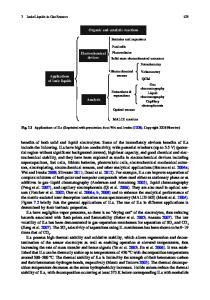Thermodynamics of interaction of ionic liquids with lipid monolayer
- PDF / 1,828,732 Bytes
- 11 Pages / 595.276 x 790.866 pts Page_size
- 14 Downloads / 330 Views
REVIEW
Thermodynamics of interaction of ionic liquids with lipid monolayer G. Bhattacharya 1 & S. Mitra 1 & P. Mandal 1 & S. Dutta 2 & R. P. Giri 3 & S. K. Ghosh 1 Received: 25 September 2017 / Accepted: 13 December 2017 # International Union for Pure and Applied Biophysics (IUPAB) and Springer-Verlag GmbH Germany, part of Springer Nature 2018
Abstract Understanding the interaction of ionic liquids with cellular membrane becomes utterly important to comprehend the activities of these liquids in living organisms. Lipid monolayer formed at the air–water interface is employed as a model system to follow this interaction by investigating important thermodynamic parameters. The penetration kinetics of the imidazolium-based ionic liquid 1-decyl-3-methylimidazolium tetrafluoroborate ([DMIM][BF4]) into the zwitterionic 1,2-dipalmitoyl-sn-glycero-3phosphocholine (DPPC) lipid layer is found to follow the Boltzmann-like equation that reveals the characteristic time constant which is observed to be the function of initial surface pressure. The enthalpy and entropy calculated from temperature-dependent pressure–area isotherms of the monolayer show that the added ionic liquids bring about a disordering effect in the lipid film. The change in Gibbs free energy indicates that an ionic liquid with longer chain has a far greater disordering effect compared to an ionic liquid with shorter chain. The differential scanning calorimetric measurement on a multilamellar vesicle system shows the main phase transition temperature to shift to a lower value, which, again, indicates the disordering effect of the ionic liquid on lipid membrane. All these studies fundamentally point out that, when ionic liquids interact with lipid molecules, the selfassembled structure of a cellular membrane gets perturbed, which may be the mechanism of these molecules having adverse effects on living organisms. Keywords Cellular membrane . Ionic liquids (ILs) . Lipid monolayer . Thermodynamics
Introduction Cellular membrane is a bilayer of lipids with proteins, cholesterol, etc. embedded within it. This membrane not only provides the protective boundary to a cell but also executes and controls many physiological functions, such as endocytosis– exocytosis processes and cell signaling (Lombard 2014). Any perturbation in the natural structure of this membrane due to This article is part of a Special Issue on ‘Ionic Liquids and Biomolecules’ edited by Antonio Benedetto and Hans-Joachim Galla. * S. K. Ghosh [email protected] 1
Department of Physics, School of Natural Sciences, Shiv Nadar University, NH-91, Tehsil Dadri, G. B. Nagar, Uttar Pradesh 201314, India
2
Department of Chemistry, School of Natural Sciences, Shiv Nadar University, NH-91, Tehsil Dadri, G. B. Nagar, Uttar Pradesh 201314, India
3
Saha Institute of Nuclear Physics, Bidhannagar, Kolkata 700064, India
interaction with an external molecule may have an impact on these functions. Ionic liquids (ILs) are such foreign molecules which have been reported to show adverse effects on living organ
Data Loading...











